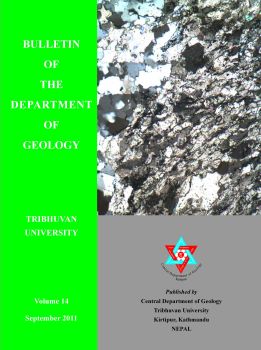Petrographic analysis of carbonate rocks for alkali-aggregate reactivity
DOI:
https://doi.org/10.3126/bdg.v14i0.5433Keywords:
petrography, rocks, rock typesAbstract
Quality of aggregate is of extreme concern when it is to be used for infrastructures. Besides, many physical and mechanicalproperties of the aggregate, presence or absence of deleterious constituents and alkali-silica reactivity are especially importantwhen aggregates are to be used in concrete structures. High potential of alkali-silica reactivity or alkali-carbonate reactivity andpresence of deleterious constituents may impair the infrastructures.A ledge rock sample from the heap to be taken for crushing was petrographically analysed for alkali-silica reactivity. Inoverall, two rock clans (dolosparstone and dolomicrosparstone) with three sub clans (rock type X, Y and Z) from the sample 2 areidentified. Rock type X (dolosparstone) constitutes 82.94% of the whole sample, and shows notable amount of quartz and calciteveins, and carbonaceous material and hematite on the mosaic of dolospars. Rock types Y (dolosparstone) and Z (dolomicrosparstone)contain trace amount of microquartz, mega quartz (>15 mm) and carbonaceous opaques. The rock type Z is dominantly composedof dolomicrospars. Major portions of all the rock types are characterised by mosaics of dolomite in association with variableamounts of muscovite, quartz, and calcite. Calcite often replaces the mosaics of dolomite and bands of quartz, forming a veinnetworks in rock types X and Y. Silica is represented by a low-temperature mega quartz either in ground or in veins, a trace amountof microquartz in rock types Y and Z. There is no other reactive silica components, thus showing a low potential to alkali-silicareactivity. However, the sample shows potential of alkali-carbonate reactivity as significant proportion of rock type havingdolomicrospars are found.
DOI: http://dx.doi.org/10.3126/bdg.v14i0.5433
Bulletin of the Department of Geology Vol.14 2011, pp.15-20
Downloads
Downloads
How to Cite
Issue
Section
License
© Central Department of Geology, Tribhuvan University, Nepal

